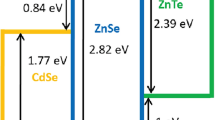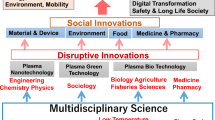Abstract
The energy utilization and kinetic characteristics in pulsed bipolar plasma catalysis of organic reactants were investigated. A kinetic theoretical formula was established for depicting the plasma dissociation and synergistic catalysis. The synergy factors of C5 − C10 n-alkanes were independent of the number of secondary hydrogens, but for (CH3)m-benzenes (m = 0 − 3), as the number of methyl groups increased, the synergy factors slightly increased. The rate of increase in energy utilization due to the synergy effect was inversely proportional to the reactivity of reactants. Some energy from plasma discharge was wasted at low conversion until the catalytic activity began to play a role. The energy utilization increased considerably once the catalytic effect was activated. However, when the reactant was close to its complete oxidation, the plasma dissociation and catalysis reactions competed with each other, leading to wastage of some of the energy. These phenomena were more remarkable for the alkanes than for the aromatics.
Graphic Abstract













Similar content being viewed by others
References
Markiewicz A, Björklund K, Eriksson E, Kalmykova Y, Strömvall AM, Siopi A (2017) Emissions of organic pollutants from traffic and roads: Priority pollutants selection and substance flow analysis. Sci Total Environ 580:1162–1174
Adam TW, Astorga C, Clairotte M, Duane M et al (2011) Chemical analysis and ozone formation potential of exhaust from dual-fuel (liquefied petroleum gas/gasoline) light duty vehicles. Atmos. Environ. 45:2842–2848
Elliott MA, Nebel GJ, Rounds FG (2012) The composition of exhaust gases from diesel, gasoline and propane powered motor coaches. J Air Pollut Control Assoc 5(2):103–109
Xiong Y, Du K (2020) Source-resolved attribution of ground-level ozone formation potential from VOC emissions in Metropolitan Vancouver. BC Sci Total Environ 721:137698
Chen CH, Chuang YC, Hsieh CC, Lee CS (2019) VOC characteristics and source apportionment at a PAMS site near an industrial complex in central Taiwan. Atmos Pollut Res 10:1060–1074
Liang CW, Ku CK, Liang JJ (2013) The scale-free network behavior of ambient volatile organic compounds. Environ Sci Pollut Res 20:872–883
Jobson BT, Berkowitz CM, Kuster WC, Goldan PD, Williams EJ, Fesenfeld FC, Apel EC, Karl T, Lonneman WA, Riemer D (2004) Hydrocarbon source signatures in Houston, Texas: influence of the petrochemical industry. J Geophys Res Atmos 109:24305–24326
Zheng H, Kong S, Yan Y, Chen N, Yao L, Liu X, Wu F, Cheng Y, Niu Z, Zheng S, Zeng X, Yan Q, Wu J, Zheng M, Liu D, Zhao D, Qi S (2020) Compositions, sources and health risks of ambient volatile organic compounds (VOCs) at a petrochemical industrial park along the Yangtze River. Sci Total Environ 703:135505
Jiang J, Feng X, Yang M, Wang Y (2020) Comparative techno economic analysis and life cycle assessment of aromatics production from methanol and naphtha. J Clean Prod 27:123525
Ma L, He M, Fu P, Jiang X, Lv W, Huang Y, Liu Y, Wan H (2020) Adsorption of volatile organic compounds on modified spherical activated carbon in a new cyclonic fluidized bed. Sep Purif Technol 235:116146
Lee JE, Ok YS, Tsang DCW, Song JH, Jung SC, Park YK (2020) Recent advances in volatile organic compounds abatement by catalysis and catalytic hybrid processes: a critical review. Sci Total Environ 719:137405
Salvador S, Commandré JM, Kara Y (2006) Thermal recuperative incineration of VOCs: CFD modelling and experimental validation. Appl Therm Eng 26:2355–2366
Whitehead JC (2019) Plasma-catalysis: Is it just a question of scale? Front Chem Sci Eng 13(2):264–273
Kim HH (2004) Nonthermal plasma processing for air-pollution control: a historical review, current issues, and future prospects. Plasma Process Polym 1:91–110
Holzer F, Roland U, Kopinke FD (2002) Combination of non-thermal plasma and heterogeneous catalysis for oxidation of volatile organic compounds Part 1. Accessibility of the intra-particle volume. Appl. Catal. B-Environ. 38:163–181
Gervasini A, Vezzoli G, Ragaini V (1996) VOC removal by synergic effect of combustion catalyst and ozone. Catal Today 29:449–455
Einaga H, Ibusuki T, Futamura S (2001) Performance evaluation of a hybrid system comprising silent discharge and manganese oxide catalysts for benzene decomposition. IEEE Trans Ind Appl 37:1476–1482
Jarrige J, Vervisch P (2009) Plasma-enhanced catalysis of propane and isopropyl alcohol at ambient temperature on a MnO2-based catalyst. Appl Catal B-Environ 90(1–2):74–82
Lin BY, Chang MB, Chen HL, Lee HM, Yu SJ, Li SN (2011) Removal of C3F8 via the combination of non-thermal plasma, adsorption and catalysis. Plasma Chem Plasma P 31:585–594
Liang CJ, Li KW (2018) Kinetic characterization of plasma-enhanced catalysis of high-concentration volatile organic compounds over mullite supported perovskite catalysts. J Electrostat 96:134–143
Xg Dang C, Qin JH, Teng J, Huang X (2016) Adsorbed benzene/toluene oxidation using plasma driven catalysis with gas circulation: Elimination of the byproducts. J Ind Eng Chem. 37:366–371
Kim HH, Ogata A, Futamur S (2006) Effect of different catalysts on the decomposition of VOCs using flow-type plasma-driven catalysis. IEEE T Plasma Sci 34(3):984–995
Kim HH, Ogata A (2011) Nonthermal plasma activates catalyst: from current understanding and future prospects. Eur Phys J Appl Phys 55:13806
C J Liang, Z Y Lee, 2020 Kinetic investigation of energy synergy in the pulsed bipolar plasma-catalytic reaction of organic waste gases over mullite-supported perovskite catalysts. Plasma Chem Plasma P. 40: 883–906.
Li J, Ma C, Zhu S, Yu F, Dai B, Yang D (2019) A review of recent advances of dielectric barrier discharge plasma in catalysis. Nanomaterials 9:1428
Sahu T, Patra AK, Behera B (2017) Effect of gadolinium doping on structural, ferroic and electrical properties of 0.8BiGdxFe1−xO3–0.2PbTiO3 (x = 0.00, 0.05, 0.10, 0.15 and 0.20) composites. J Alloys Compd 695:2273–2284
Gao W, Zhu Y, Wang Y, Yuan G, Liu JM (2020) A review of flexible perovskite oxide ferroelectric films and their application. J Materiomics 6:1–16
Liang CJ, Fang JW (2016) Predicting the kinetics of catalytic oxidation of multicomponent organic waste gases. Chem Eng Sci 144:101–107
Wang W, Yuan F, Niu X, Zhu Y (2016) Preparation of Pd supported on La(Sr)-Mn-O perovskite by microwave irradiation method and its catalytic performances for the methane combustion. Sci Rep 6:19511
Chen HL, Lee HM, Cheng LC, Chang MB, Yu SJ, Li SN (2008) Influence of nonthermal plasma reactor type on CF4 and SF6 abatements. IEEE Trans Plasma Sci 36:509–515
Uhm HS, Hong YC (2011) Various micro plasma jets and their sterilization of microbes. Thin Solid Films 519:6974–6980
Lee DH, Kim KT, Cha MS, Song YH (2007) Optimization scheme of a rotating gliding arc reactor for partial oxidation of methane. Proc Combust Inst 31:3343–3351
Yuan D, Tang S, Qi J, Li N, Gu J, Huang H (2017) Comparison of hydroxyl radical generation during granular activated carbon regeneration in DBD reactor driven by bipolar pulse power and alternating current power. Vacuum 143:87–94
M H Chiang, K C Liao, I M Lin, C C Lu, H Y Huang, C L Kuo, J S Wu, C C Hsu, S H Chen, 2010 Effects of oxygen addition and treating distance on surface cleaning of ITO Glass by a non-equilibrium nitrogen atmospheric-pressure plasma jet. Plasma Chem Plasma P 30: 553–563.
Wilson EK (2006) Explaining C-H bond strengths: alternative to hyperconjugation invokes steric strain, but not everyone is buying the idea. Chem Eng News 84(10):65
Long AK, Fawcett JA, Clyburne JAC, Pye CC (2016) RADMAP: Simple probes for rapid assessment of complex reactivity: a method and case studies on the reaction of hydrogen atoms with unsaturated organic molecules. J Mol Graph Model 64:147–152
Liang CJ, Lee ZY (2020) Effects of oxygen-containing functional groups on the synergy effect in pulsed bipolar plasma-catalytic reactions of volatile organic compounds. RSC Adv 10:11400
Montazersadgh F, Wright A, Ren J, Shaw A, Neretti G, Bandulasena H, Iza F (2019) Influence of the on-time on the ozone production in pulsed dielectric barrier discharges. Plasma 2:39–50
Li J, Sun W, Pashaie B, Dhali SK (1995) Streamer discharge simulation in flue gas. IEEE Trans Plasma Sci 23:672–678
Kim HH, Prieto G, Takashima K, Katsura S, Mizuno A (2002) Performance evaluation of discharge plasma process for gaseous pollutant removal. J Electrost 55:25–41
Acknowledgements
The authors would like to thank the Ministry of Science and Technology of the Republic of China, Taiwan, for financially supporting this research under Contract No. MOST 105-2221-E-035-025, MOST 106-2221-E-035-043, and MOST 108-2221-E-035-045-MY3.
Author information
Authors and Affiliations
Corresponding author
Ethics declarations
Conflict of interest
The authors declare that they have no conflict of interest.
Additional information
Publisher's Note
Springer Nature remains neutral with regard to jurisdictional claims in published maps and institutional affiliations.
Rights and permissions
About this article
Cite this article
Liang, CJ., Huang, KY. Energy Utilization and Kinetic Characteristics Due to Plasma-Catalytic Synergy Effect with Reactant Structurally Bond Strength and Inductive Effect. Plasma Chem Plasma Process 41, 1039–1058 (2021). https://doi.org/10.1007/s11090-021-10163-w
Received:
Accepted:
Published:
Issue Date:
DOI: https://doi.org/10.1007/s11090-021-10163-w




